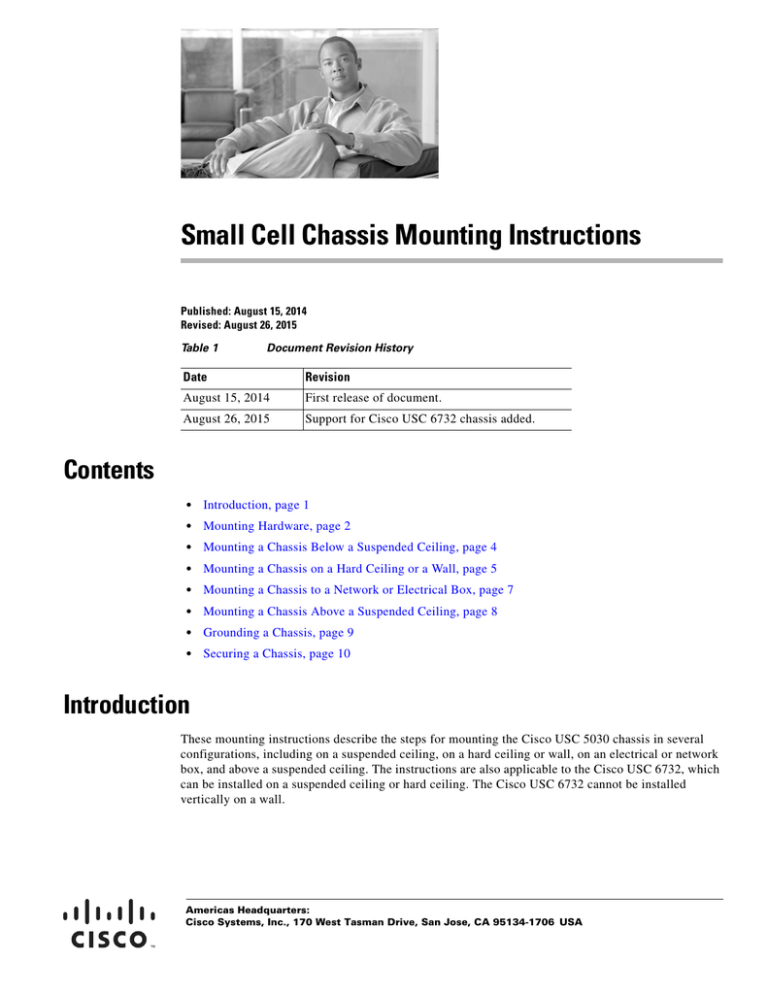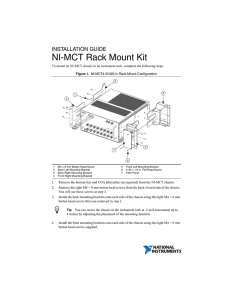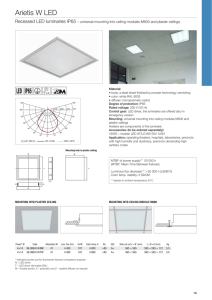
Small Cell Chassis Mounting Instructions
Published: August 15, 2014
Revised: August 26, 2015
Table 1
Document Revision History
Date
Revision
August 15, 2014
First release of document.
August 26, 2015
Support for Cisco USC 6732 chassis added.
Contents
•
Introduction, page 1
•
Mounting Hardware, page 2
•
Mounting a Chassis Below a Suspended Ceiling, page 4
•
Mounting a Chassis on a Hard Ceiling or a Wall, page 5
•
Mounting a Chassis to a Network or Electrical Box, page 7
•
Mounting a Chassis Above a Suspended Ceiling, page 8
•
Grounding a Chassis, page 9
•
Securing a Chassis, page 10
Introduction
These mounting instructions describe the steps for mounting the Cisco USC 5030 chassis in several
configurations, including on a suspended ceiling, on a hard ceiling or wall, on an electrical or network
box, and above a suspended ceiling. The instructions are also applicable to the Cisco USC 6732, which
can be installed on a suspended ceiling or hard ceiling. The Cisco USC 6732 cannot be installed
vertically on a wall.
Americas Headquarters:
Cisco Systems, Inc., 170 West Tasman Drive, San Jose, CA 95134-1706 USA
Mounting Hardware
Mounting Hardware
Mounting hardware for the small cell chassis consists of brackets, which connect to the bottom of the
chassis, and ceiling grid clips, which connect the bracket to a suspended ceiling. The bracket that you
need depends on the mounting location for the chassis. The ceiling grid clip that you need depends on
the type of suspended ceiling where you need to install the chassis. You don’t need ceiling grid clips if
you are mounting the chassis to a hard-surface ceiling or a wall.
Mounting Bracket
The universal bracket (AIR-AP-BRACKET-2) is versatile (it works with electrical boxes, can be used
for wall mounting, and adapts to ceiling installations), but leaves a larger gap between the mounting
surface and the chassis than the low-profile bracket. The larger gap is necessary in some locations
because it allows space for cable routing. Figure 1 shows the universal bracket installed on a chassis.
Universal Bracket Installed on a Chassis
272384
Figure 1
Ceiling Grid Clips
You use a ceiling grid clip to mount a chassis on a suspended ceiling. The ceiling grid clip that you need
depends on the ceiling tiles on your ceiling. There are two types of ceiling grid clips:
•
Ceiling Grid Clip, Recessed (AIR-AP-T-RAIL-R)—If your ceiling tiles hang below the ceiling grid,
this clip provides the best fit between the AP and the ceiling.
•
Ceiling Grid Clip, Flush (AIR-AP-T-RAIL-F)—If your ceiling tiles are flush with the ceiling grid,
this clip provides a snug fit between the AP and the ceiling.
Figure 2 shows a ceiling grid clip.
Small Cell Chassis Mounting Instructions
2
Mounting Hardware
Figure 2
Ceiling Grid Clip
1
2
2
3
C
15
24
C
9/16
B
B
15
9/16
15/16
24
15/16
38
MM
INCH
1-1/2
CEILING
GRID
A
WIDTH
38
MM
INCH 1-1/2
CEILING
GRID
A
WIDTH
3
2
121758
2
1
1
Locking screws
2
Bracket screw holes
3
T-rail width detents (A, B, or C)
Additional Adapters for Channel and Beam Ceiling Rails
The most common type of ceiling rail (the supports for the ceiling tiles) is the T-rail. You can attach a
ceiling grid clip directly to a T-rail ceiling rail. However, other types of ceiling rails, such as channel
rails and beam rails, require an additional adapter clip (AIR-CHNL-ADAPTER). You need two adapter
clips for each chassis. Setscrews on the clips hold them securely on the ceiling rail.
Figure 3 shows the three types of ceiling rails: T-rail, channel, and beam. Figure 4 shows a chassis
installed with mounting bracket, ceiling grid clip, and adapter clips.
T-Rail, Channel, and Beam Ceiling Rail Types
281531
Figure 3
Small Cell Chassis Mounting Instructions
3
Mounting a Chassis Below a Suspended Ceiling
Figure 4
Adapter Clips Installed with Ceiling Grid Clips
281532
Adapter clips
Ceiling grid
clip
Access
point
Mounting
bracket
Mounting a Chassis Below a Suspended Ceiling
Follow these steps to mount the chassis below a standard or recessed suspended ceiling. Figure 5 shows
a chassis mounted on a T-rail ceiling rail using a ceiling grid clip.
Suspended Ceiling Mounting Details
272375
Figure 5
1
2
5
3
4
1
Chassis mounting keyhole
4
Chassis cable access cover
2
Ceiling grid clip
5
Ceiling T-rail
3
Grounding point
Small Cell Chassis Mounting Instructions
4
Mounting a Chassis on a Hard Ceiling or a Wall
Follow these steps to mount the chassis below a suspended ceiling.
Step 1
Decide where you want to mount the chassis on your suspended ceiling.
Step 2
Open the ceiling grid clip completely.
Step 3
Place the ceiling grid clip over the T-rail and close it to the appropriate detent (A, B, or C).
Step 4
Use a screwdriver to tighten the two ceiling grid clip locking screws to prevent the clip from sliding
along the T-rail.
Step 5
Observe the ceiling grid clip width detent letter (A, B, or C) that corresponds to the T-rail width.
Step 6
Align the corresponding holes (A, B, or C) on the mounting bracket over the mounting holes on the
ceiling grid clip.
Step 7
Hold the mounting bracket and insert a 6-32 x 1/4 in. screw into each of the four corresponding holes
(A, B, or C) and tighten.
Step 8
If necessary, drill or cut a cable access hole in the ceiling tile large enough for the Ethernet and power
cables. Pull the cables through the access hole until you have about 1 foot of cable protruding from the
hole.
Step 9
(Optional) Use the ground screw to ground the chassis to a suitable building ground. See the “Grounding
a Chassis” section on page 9 for general grounding instructions.
Step 10
Connect the Ethernet and power cables to the chassis.
Step 11
Align the chassis feet over the keyhole mounting slots on the mounting bracket. If you created a hole for
the cables, make sure the chassis is positioned so that the cables reach their respective ports.
Step 12
Gently slide the chassis onto the mounting bracket until it clicks into place.
Mounting a Chassis on a Hard Ceiling or a Wall
This procedure describes the steps required to mount the chassis on a ceiling constructed of 3/4-in
(19.05-mm) or thicker plywood using #8 fasteners using the universal mounting bracket
(AIR-AP-BRACKET-2).
Follow these steps to mount the chassis on a solid ceiling or wall.
Step 1
Use the mounting bracket as a template to mark the locations of the mounting holes on the bracket.
Figure 6 shows details of the mounting bracket.
Caution
Be sure to mark all four locations. To ensure a safe and secure installation, make sure you are using
adequate fasteners and mount the chassis using no less than four fasteners.
Mise en garde: Assurez-vous de marquer les quatre emplacements. Pour garantir une installation sûre,
utilisez des attaches adéquates et installez le châssis sans omettre une seule des quatre attaches.
Caution
Do not use plastic wall anchors or the keyhole slots on the mounting bracket for ceiling installations.
When mounting the chassis on a hard ceiling, use four fasteners capable of maintaining a minimum
pullout force of 20 lbs (9 kg).
Small Cell Chassis Mounting Instructions
5
Mounting a Chassis on a Hard Ceiling or a Wall
Mise en garde: Dans le cas d'une 'installation au plafond, n'utilisez pas de dispositifs d'ancrage au mur
en plastique ni les encoches en trou de serrure du support de montage. Pour installer le châssis sur un
plafond dur, vous devez utiliser quatre attaches capables de soutenir une force d'arrachement minimale
de 9 kg (20 livres).
Figure 6
Universal Mounting Bracket Details
1
2
2
3
2
5
Step 2
4
1
Bracket locking post (used when attaching the
bracket to a previously mounted bracket)
4
2
Chassis mounting keyholes
3
Grounding post
5
Cable access cover
Security hasp
Use a #29 drill (0.1360-in. [3.4772 mm]) bit to drill a pilot hole at the mounting hole locations you
marked.
Small Cell Chassis Mounting Instructions
6
207612
2
Mounting a Chassis to a Network or Electrical Box
Note
The pilot hole size varies according to the material and thickness you are fastening. Cisco
recommends that you test the material to determine the ideal hole size for your mounting
application.
Step 3
(Optional) Drill or cut a cable access hole near and below the location of the mounting bracket cable
access cover large enough for the Ethernet cable, building ground wire, and power cables.
Step 4
Pull approximately 9 inches of cable through the hole. Route the Ethernet and power cables through the
bracket before you attach the bracket to the ceiling or wall. Route the cables through the main cable
access hole and then through the smaller access hole as shown in Figure 7.
Routing the Ethernet and Power Cables
207614
Figure 7
Step 5
(Optional) Use the ground screw to attach the building ground wire to the mounting bracket. See the
“Grounding a Chassis” section on page 9 for general grounding instructions.
Step 6
Position the mounting bracket mounting holes (with indents down) over the pilot holes.
Step 7
Insert a fastener into each mounting hole and tighten.
Step 8
Connect the Ethernet and power cables to the chassis.
Step 9
Align the chassis feet with the large part of the keyhole mounting slots on the mounting plate. When
positioned correctly, the cable access cover will fit inside the chassis connector bay.
Step 10
Gently slide the chassis onto the mounting bracket keyhole slots until it clicks into place.
Mounting a Chassis to a Network or Electrical Box
Follow these steps to mount a chassis to a network box or an electrical box.
Small Cell Chassis Mounting Instructions
7
Mounting a Chassis Above a Suspended Ceiling
Step 1
Position the universal mounting bracket (AIR-AP-BRACKET-2) over the existing network or electrical
box and align the bracket mounting holes with the box holes.
Step 2
Hold the mounting bracket in place and insert a 6 x 32 x 1/4-in pan head screw into each of the mounting
holes and tighten.
Step 3
Pull approximately 9 inches of Ethernet and power cable through the hole. Route the cables through the
bracket before you attach the bracket to the ceiling. Route the cables through the main cable access hole
and then through the smaller access hole as shown in Figure 7.
Step 4
(Optional) Use the ground screw to attach the building ground wire to the mounting bracket. See the
“Grounding a Chassis” section on page 9 for general grounding instructions.
Step 5
Connect the Ethernet and power cables to the chassis.
Step 6
Align the chassis feet over the keyhole mounting slots on the optional mounting bracket.
Step 7
Slide the chassis onto the optional mounting bracket until it clicks into place.
Mounting a Chassis Above a Suspended Ceiling
Using third-party accessories (not offered by Cisco) you can mount a chassis above a suspended ceiling.
The universal mounting bracket (AIR-AP-BRACKET-2) supports a T-bar box hanger such as the Erico
Caddy 512A or the Cooper B-Line BA50a. The box hanger should be oriented just above the top surface
of a ceiling tile. If your ceiling uses particularly thick tiles, you might need to modify the tile to allow
room for the chassis or use a box hanger that allows you to adjust the height of the chassis, such as the
Cooper B-Line BA50A.
Note
Install a chassis above ceiling tiles only when mounting below the ceiling is not an option. Mounting a
chassis above the ceiling can interfere with advanced wireless LAN features that depend on uniform
coverage, such as voice and location.
Follow these steps to mount the chassis above a suspended ceiling. Figure 8 shows the completed
installation.
Figure 8
T-Bar Grid Mounting Bracket Parts
6
1
2
3
6
1
5
Small Cell Chassis Mounting Instructions
8
121838
4
Grounding a Chassis
1
Suspended ceiling T-rail
4
Mounting bracket
2
Box hanger
5
Chassis
3
Box hanger clip
6
T-rail clip
Step 1
Remove a ceiling tile adjacent to the mounting location.
Step 2
Fasten the chassis mounting bracket to the box hanger using the clip or screws provided with the box
hanger kit.
Step 3
Pull approximately 9 inches of Ethernet and power cable through the mounting bracket. Route the cables
through the main cable access hole and then through the smaller access hole as shown in Figure 7.
Step 4
Connect the Ethernet and power cables to the chassis.
Step 5
Align the chassis feet over the keyhole mounting slots on the mounting bracket.
Step 6
Slide the chassis onto the mounting bracket until it clicks into place.
Step 7
Attach the T-rail clips on each end of the T-bar box hanger to the ceiling rails. Make sure the clips are
securely attached to the T-rails.
Step 8
Replace the ceiling tile.
Grounding a Chassis
Grounding is not always required for indoor installations because the USC 5030 chassis is classified as
low-voltage devices and do not contain internal power supplies. However, Cisco recommends that you
check your local and national electrical codes to see if grounding is a requirement. If grounding is
required in your area or you wish to ground your chassis, follow these steps.
Note
Do not ground the USC 6732 chassis. If required, use a shielded cable.
Step 1
Find a suitable building grounding point as close to the chassis as possible.
Step 2
Connect a user-supplied ground wire to the building grounding point. The wire should be a minimum of
#14AWG assuming a circuit length of 25 ft (30.5 cm). Consult your local electrical codes for additional
information.
Step 3
Route the ground wire to the chassis.
Step 4
Attach the wire to a suitable grounding O-ring lug.
Step 5
Crimp or solder the wire to the lug.
Step 6
Insert the grounding post screw into the O-ring lug and install it on the mounting bracket as shown in
Figure 9.
Small Cell Chassis Mounting Instructions
9
Securing a Chassis
Installing the O-Ring Lug to the Grounding Post
272428
Figure 9
Step 7
Use a Phillips screwdriver to tighten the ground screw.
Securing a Chassis
There are two ways to secure your chassis:
•
Attach it to an immovable object with a security cable.
•
Lock it to the mounting plate with a padlock.
Using a Security Cable
You can secure the chassis by installing a standard security cable (such as the Kensington Notebook
MicroSaver, model number 64068) into the chassis security cable slot as shown in Figure 10.
The security cable can be used with any of the mounting methods described in this guide.
Follow these steps to install the security cable.
Step 1
Loop the security cable around a nearby immovable object.
Step 2
Insert the key into the security cable lock.
Step 3
Insert the security cable latch into the security cable slot on the chassis.
Step 4
Rotate the key right or left to secure the security cable lock to the chassis.
Step 5
Remove the key.
Small Cell Chassis Mounting Instructions
10
Securing a Chassis
Security Cable Details
272379
Figure 10
Securing the Chassis to the Mounting Plate
Use the security hasp on the adapter cable access cover and a padlock (that you provide) to secure your
chassis to the mounting plate. Compatible padlocks are Master Lock models 120T or 121T. The cable
access cover on the mounting bracket covers the cable bay area (including the power port, Ethernet port,
console port, and the mode button) to prevent the installation or removal of the cables or the activation
of the mode button.
Follow these instructions to install the padlock:
Step 1
With the chassis installed on the mounting bracket, insert a padlock into the security hasp.
Note
If your chassis is mounted to a hard ceiling, the clearance between the mounting bracket and
the ceiling is small. Work slowly using both hands to position and secure the lock into the
mounting bracket hasp.
Step 2
Rotate the lock clockwise and align the bail with the lock body.
Step 3
Grasp the lock and push it into the bail to lock the lock. See Figure 11.
Small Cell Chassis Mounting Instructions
11
Securing a Chassis
Inserting the Padlock into the Security Hasp
272382
Figure 11
Step 4
Rotate the padlock into the padlock area. See Figure 12.
Rotating the Padlock into the Padlock Area
272383
Figure 12
Obtaining Documentation and Submitting a Service Request
For information on obtaining documentation, submitting a service request, and gathering additional
information, see the monthly What’s New in Cisco Product Documentation, which also lists all new and
revised Cisco technical documentation, at:
http://www.cisco.com/en/US/docs/general/whatsnew/whatsnew.html
Subscribe to the What’s New in Cisco Product Documentation as a Really Simple Syndication (RSS) feed
and set content to be delivered directly to your desktop using a reader application. The RSS feeds are a free
service and Cisco currently supports RSS Version 2.0.
Cisco and the Cisco logo are trademarks or registered trademarks of Cisco and/or its affiliates in the U.S. and other countries. To view a list of
Cisco trademarks, go to this URL: www.cisco.com/go/trademarks. Third-party trademarks mentioned are the property of their respective owners. The
use of the word partner does not imply a partnership relationship between Cisco and any other company. (1110R)
© 2015 Cisco Systems, Inc. All rights reserved.
Small Cell Chassis Mounting Instructions
12



